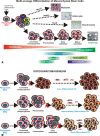Osteosarcoma development and stem cell differentiation
- PMID: 18563507
- PMCID: PMC2492997
- DOI: 10.1007/s11999-008-0335-z
Osteosarcoma development and stem cell differentiation
Abstract
Osteosarcoma is the most common nonhematologic malignancy of bone in children and adults. The peak incidence occurs in the second decade of life, with a smaller peak after age 50. Osteosarcoma typically arises around the growth plate of long bones. Most osteosarcoma tumors are of high grade and tend to develop pulmonary metastases. Despite clinical improvements, patients with metastatic or recurrent diseases have a poor prognosis. Here, we reviewed the current understanding of human osteosarcoma, with an emphasis on potential links between defective osteogenic differentiation and bone tumorigenesis. Existing data indicate osteosarcoma tumors display a broad range of genetic and molecular alterations, including the gains, losses, or arrangements of chromosomal regions, inactivation of tumor suppressor genes, and the deregulation of major signaling pathways. However, except for p53 and/or RB mutations, most alterations are not constantly detected in the majority of osteosarcoma tumors. With a rapid expansion of our knowledge about stem cell biology, emerging evidence suggests osteosarcoma should be regarded as a differentiation disease caused by genetic and epigenetic changes that interrupt osteoblast differentiation from mesenchymal stem cells. Understanding the molecular pathogenesis of human osteosarcoma could ultimately lead to the development of diagnostic and prognostic markers, as well as targeted therapeutics for osteosarcoma patients.
Figures

Similar articles
-
A murine mesenchymal stem cell model for initiating events in osteosarcomagenesis points to CDK4/CDK6 inhibition as a therapeutic target.Lab Invest. 2022 Apr;102(4):391-400. doi: 10.1038/s41374-021-00709-z. Epub 2021 Dec 17. Lab Invest. 2022. PMID: 34921235 Free PMC article.
-
Involvement of INK4A gene products in the pathogenesis and development of human osteosarcoma.Cancer. 2001 Dec 15;92(12):3062-7. doi: 10.1002/1097-0142(20011215)92:12<3062::aid-cncr10161>3.0.co;2-x. Cancer. 2001. PMID: 11753985
-
Alterations in the INK4a/ARF locus and their effects on the growth of human osteosarcoma cell lines.Cancer Genet Cytogenet. 2002 Mar;133(2):105-11. doi: 10.1016/s0165-4608(01)00575-1. Cancer Genet Cytogenet. 2002. PMID: 11943335
-
Biology of osteogenic sarcoma.Cancer J. 2005 Jul-Aug;11(4):294-305. doi: 10.1097/00130404-200507000-00005. Cancer J. 2005. PMID: 16197719 Review.
-
Molecular pathogenesis of osteosarcoma.DNA Cell Biol. 2007 Jan;26(1):1-18. doi: 10.1089/dna.2006.0505. DNA Cell Biol. 2007. PMID: 17263592 Review.
Cited by
-
miR-23a impairs bone differentiation in osteosarcoma via down-regulation of GJA1.Front Genet. 2015 Jul 2;6:233. doi: 10.3389/fgene.2015.00233. eCollection 2015. Front Genet. 2015. PMID: 26191074 Free PMC article.
-
Osteosarcoma: Cells-of-Origin, Cancer Stem Cells, and Targeted Therapies.Stem Cells Int. 2016;2016:3631764. doi: 10.1155/2016/3631764. Epub 2016 Jun 5. Stem Cells Int. 2016. PMID: 27366153 Free PMC article. Review.
-
β-Catenin Does Not Confer Tumorigenicity When Introduced into Partially Transformed Human Mesenchymal Stem Cells.Sarcoma. 2012;2012:164803. doi: 10.1155/2012/164803. Epub 2012 Oct 18. Sarcoma. 2012. PMID: 23125530 Free PMC article.
-
Alpha-CaMKII plays a critical role in determining the aggressive behavior of human osteosarcoma.Mol Cancer Res. 2013 Apr;11(4):349-59. doi: 10.1158/1541-7786.MCR-12-0572. Epub 2013 Jan 30. Mol Cancer Res. 2013. PMID: 23364534 Free PMC article.
-
Genetically engineered mouse models and human osteosarcoma.Clin Sarcoma Res. 2012 Oct 4;2(1):19. doi: 10.1186/2045-3329-2-19. Clin Sarcoma Res. 2012. PMID: 23036272 Free PMC article.
References
-
- {'text': '', 'ref_index': 1, 'ids': [{'type': 'PubMed', 'value': '6595610', 'is_inner': True, 'url': 'https://pubmed.ncbi.nlm.nih.gov/6595610/'}]}
- Abramson DH, Ellsworth RM, Kitchin FD, Tung G. Second nonocular tumors in retinoblastoma survivors. Are they radiation-induced? Ophthalmology. 1984;91:1351–1355. - PubMed
-
- {'text': '', 'ref_index': 1, 'ids': [{'type': 'PubMed', 'value': '11277399', 'is_inner': True, 'url': 'https://pubmed.ncbi.nlm.nih.gov/11277399/'}]}
- Alonso J, Garcia-Miguel P, Abelairas J, Mendiola M, Pestana A. A microsatellite fluorescent method for linkage analysis in familial retinoblastoma and deletion detection at the RB1 locus in retinoblastoma and osteosarcoma. Diagn Mol Pathol. 2001;10:9–14. - PubMed
-
- {'text': '', 'ref_index': 1, 'ids': [{'type': 'PubMed', 'value': '8425179', 'is_inner': True, 'url': 'https://pubmed.ncbi.nlm.nih.gov/8425179/'}]}
- Andreassen A, Oyjord T, Hovig E, Holm R, Florenes VA, Nesland JM, Myklebost O, Hoie J, Bruland OS, Borresen AL, et al. p53 abnormalities in different subtypes of human sarcomas. Cancer Res. 1993;53:468–471. - PubMed
-
- {'text': '', 'ref_index': 1, 'ids': [{'type': 'PubMed', 'value': '1884549', 'is_inner': True, 'url': 'https://pubmed.ncbi.nlm.nih.gov/1884549/'}]}
- Araki N, Uchida A, Kimura T, Yoshikawa H, Aoki Y, Ueda T, Takai S, Miki T, Ono K. Involvement of the retinoblastoma gene in primary osteosarcomas and other bone and soft-tissue tumors. Clin Orthop Relat Res. 1991;270:271–277. - PubMed
-
- {'text': '', 'ref_index': 1, 'ids': [{'type': 'PMC', 'value': 'PMC5295501', 'is_inner': False, 'url': 'https://pmc.ncbi.nlm.nih.gov/articles/PMC5295501/'}, {'type': 'PubMed', 'value': '9831112', 'is_inner': True, 'url': 'https://pubmed.ncbi.nlm.nih.gov/9831112/'}]}
- Aue G, Muralidhar B, Schwartz HS, Butler MG. Telomerase activity in skeletal sarcomas. Ann Surg Oncol. 1998;5:627–634. - PMC - PubMed
Publication types
MeSH terms
Substances
LinkOut - more resources
Full Text Sources
Other Literature Sources
Medical
Research Materials
Miscellaneous

